Hiroshi Tada (多田 宏) sensei’s family were originally samurai of the Tsushima-han. Initiated into Budo by his great-grandfather, a master of Japanese archery, he went on to study Karate with Shotokan Karate founder Gichin Funakoshi, and then became a student at Ueshiba Dojo in 1948.
Here are some impressions of Tada sensei from Ellis Amdur:
Tada sensei was an icy, formidable presence when I trained in the 1970’s. He has a face like a blade, with piercing black eyes. To my eyes, he was the purest budoka of any of the Aikikai shihan. From what others have told me, he has close friends, particularly in Italy, and a fine marriage before his wife’s untimely death. He is a cultured and well-educated man, by no means an ascetic. All of that aside — or perhaps, better said, in parallel — he is utterly focused on his own path. Although he is a meticulous instructor, breaking down techniques in fine detail, somehow one has no sense that he teaches as a vocation: rather, he makes himself available for others to learn from as he pursues his own way.
You can read the rest of Ellis Amdur’s impressions of Tada sensei in It Had to be Felt #6: Tada Hiroshi: “Like an Eagle”.
You may also be interested in this eight part interview with Tada sensei conducted by Tatsuro Uchida, who is a well known Japanese author and a long-time student of Hiroshi Tada:
This is the fourth part of the English translation of a lecture given by Hiroshi Tada sensei at the 15th anniversary of the Yachimata Aikido Association on September 26th 2004. You may wish to read Part 1, Part 2 and Part 3 before reading this section.
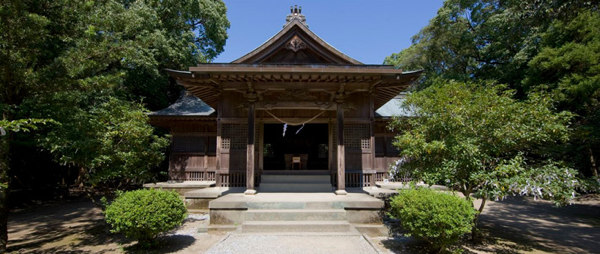 Eda Shrine (江田神社) in Miyazaki Prefecture
Eda Shrine (江田神社) in Miyazaki Prefecture
This shrine was built on the Odo district where Misogi was born
Aikido Shihan Hiroshi Tada – the Yachimata Lecture, Part 4
(translated by Christopher Li)
O-Sensei said that Aiki is “Odo no Kamuwaza” (the “divine technique of the small door” / 小戸の神技).
*Translator’s Note: This is further explicated in the first line of the “Norito” (Shinto prayer / 祝詞) chanted at shrines throughout Japan, which is paraphrased by Morihei Ueshiba here in this passage from “Takemusu Aiki”:
筑紫の日向の橘の小戸の阿波岐原で大祓戸の大神がみそぎたもうた、そのみ振舞より合気道はうまれたのであります。
O-Haraedo-no-Okami (“the Goddesses of Purification”) were created through the Misogi at Awagihara, located in Odo district of Tachibana area in Hyuga (now Miyazaki Prefecture) of Tsukushi (now Kyushu), and from that action Aikido was born.
“Odo” is actually referring to the place where Izanagi-no-Mikoto performed the Misogi ritual after returning from the land of the dead (“Yomi” / 黄泉). In other words, the “divine technique” of “Odo” is “Misogi”.
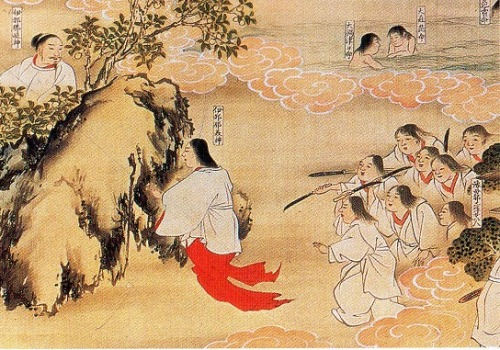 Izanami pursues Izanagi from the Land of the Dead
Izanami pursues Izanagi from the Land of the Dead
This is from the Kojiki, from a story about Izanagi and Izanami. Izanagi longed after his deceased wife Izanami, and went to meet her in the land of the dead. He had been warned not to look at her, but when he did anyway she began to chase him, bringing the legions of the dead with her. After that he cleansed his body and the gods were born from the Misogi.
*Translator’s note: Izanagi gave birth to three gods during the cleansing of Misogi – Amaterasu (the sun goddess) from his left eye, Tsukuyomi (the moon god) from his right eye and Susanoo (the tempest or storm god) from his nose. Susanoo was a particular patron of Morihei Ueshiba and Aikido.
Then, when the legions of the underworld pressed forward, Izanagi-no-Mikoto threw a peach pit and held them back. At the time of the International Congress there was someone who said that the Founder said “Aikido is the technique of the peach pit”. Perhaps this kind of story has something to do with “Momotaro” (“Peach Boy” / 桃太郎).
Further, O-Sensei said “Aikido is Misogi” (合気道は禊ぎ技である). I won’t explain all of this in detail, but I think that Sensei was explaining the “state of Shuchu” in his own way.
So this means that the way that one thinks about things related to Aikido is of great importance.
I am already 75 years old, and most of my friends already suffer from illness. When that happens the illness becomes the “object”. In sports one doesn’t really have this problem, because it’s not a matter of much importance. Of course, things like winning a gold medal are important, but there’s no chance of dying. There is no chance that you will be killed. Your life is the reward.
In the case of “illness”, or in the matches with live blades of the training in ancient times, or during the wars of recent times, if the object becomes the master then the mind stops and the body will not be able to move. This is the meaning of death.
For that reason, Budo says over and over that one must not create an object. The “state of Shuchu” means not to create an enemy inside your own mind. It is because you do not create an enemy that your mind can become the immovable mind. The word “immovable mind” (“fudoshin” / 不動心) is often used, and the meaning of “fudoshin” is to not create an enemy within your own mind. Even if an enemy is actually in front of your eyes, your own mind just observes quietly and no enemy is created in your mind. If you can hold your mind in this way you become extremely stable.
It is the same thing with “illness”. When one is suffering from “illness” then that sickness becomes the object, the sickness becomes the master and one finds themselves chasing afterwards. This is a great problem. That is, when human beings have a comparison, an object, or a competition in mind they somehow lose all sense of stability. This is because when one desires to defeat all comers, no matter how strong, or to avoid losing, a tension arises within one’s own mind. In other words, if one does not create an enemy within their own mind then this tension will not arise and one will remain tranquil. That condition is called the Immovable Mind.
The other day, when I was speaking to a professor at Tokyo University named Takashi Suzuki (鈴木たかし), who is studying the Ottoman Turks, we discussed the possibility that this use of the mind will become the most important issue for the future of Gerontology. Perhaps it will form the foundation of that field in the future.
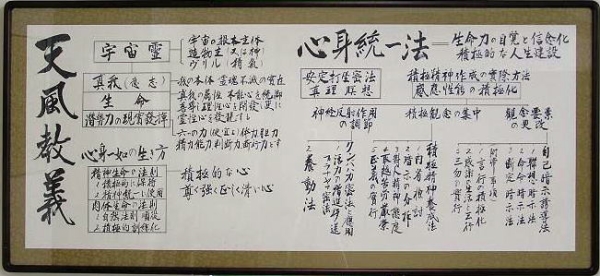 The Shin-Shin Toitsu Method of the Tempukai
The Shin-Shin Toitsu Method of the Tempukai
Showing the terms “life force” (生命の力) and Sekkyoku-shin” (“positive mind” / 積極心)
Considering Gerontology, in other words, as a training method for “life force” (生命の力), might not Aikido be the most superior solution? That is to say, now we think of everything as competing and winning, but this is not a superior method of making use of a human being’s life force. It could be said that it does not match well with the principles of the universe. If one makes use of what I have explained to this point, then they may be able to realize the wisdom and power of the universe through a tranquil and transparent mind. These have been fundamental principles throughout the long history of human beings. Aikido has superior points as a method of physically expressing these principles.
Well then, here we will discuss how to avoid the “state of Keichu” in Aikido, and what practice and training methods do not come into conflict with the “state of Shuchu”. First, you must forge your Kokyu and receive Ki into the nerves of your entire body. In sum, and this must include your own techniques, you must practice in a way in which your mind is not taken by the object.
For example, when one cannot move their legs freely they somehow fall into the state of “Keichu”.
O-Sensei explained the “state of Shuchu” in this way – “When I move, technique is born” (動けば技が生まれる). When one moves with an empty mind (“Mushin” / 無心), technique are born. Or possibly, techniques are envisioned – newly created. This doesn’t mean application of a technique that one already knows upon an opponent, this means that the principles of technique that have entered one’s body mix together and give birth to a new technique at the moment one moves. It won’t work if you have to think about it in order to do it – this is why it is important not to stop the mind. If the mind is stopped then there is no way that any technique will come forth. If you don’t think this way than I can’t explain it to you. It is the idea of the creation of technique.
In other words, O-Sensei was saying that one must practice in a unified state. That is what he was saying, even though it is a little difficult to understand.
The “state of Keichu” is a way of thinking about things relatively, “the state of Shuchu” is a way of thinking about things absolutely. This is not the same absolutely as it is used in physics. This is the way of using the mind in accordance with the principles of the universe. The “state of Keichu” is more of a way using the mind in such a way that the earth’s environment is at the mercy of human power.
So, in Kokyu-ho one simultaneously accepts the two requirements to receive the oxygen of the earth and to accept the universal Ki that moves the universe itself. When we are speaking of oxygen, of course there is some power in the world that brings the thing called oxygen into existence. Through breathing one receives that power.
“Kuki” (“air” / 空気) is a subset of Ki. If Kuki is separated from the Earth than it disappears, but Ki fills the universe. That is because what we call the universe is the action of Ki. For example, the reason why a rocket can still fly when it separates from the earth is that the universe is filled with Ki and the power which brings it into existence and the fundamental principles behind it are operating properly. If that were not so it would not even be able to exist for a moment. Well, I think that all of you know this.
Be that as it may, for Aikido training the automatic creation of technique by the body must be the fundamental training method. From the beginning you must not use a training method which cannot be executed without conscious thought.
For example, in the movement of the legs, when the opponent comes to strike one must move simultaneously with the strike. For that reason we have built a foundational training method in which one automatically moves correctly from the very beginning. You must train in these leg exercises hard for about six months. Your body will become able to move without thinking.
Further, if one learns the steps in the form of a Kata they will be unable to move. Somehow one’s head always ends up thinking about the Kata. This is one of the reasons why O-Sensei did not attach names to the techniques. You must take extreme care about this in your Aikido training in the future, it is a difficult point. Also, I am not saying that it is a good thing to just thrash around by instinct in your training. You must know the fundamental principles well. There is an exponential difference in effectiveness between doing something when you know what is happening and doing something when you don’t know anything.
We can try to understand this in terms of a ship’s compass – if you try to cross the Pacific in a ship without a compass it will be a big problem! It’s because we have a compass we know that if we go in this direction that we will reach America. In a manner of speaking, the compass is the same as the principles.
In another example, if one rides on the Tokaido Line train they will pass through Shizuoka, Nagoya, Kyoto and the station in between until they reach their destination. The train in the “state of Keichu” the train in the “state of Shuchu” are on different tracks from the beginning. Stated extremely, they are going in completely opposite directions. You must know this well. The physical education departments of most universities go towards the “state of Keichu”.
In other words, it is important to know the principles behind cause and effect and build a mind that will not be taken in from the beginning. Completely ignore such things as who is strong and who is weak, win and loss – you must first absorb the principles into your body. If you do this, then as a result you will achieve a better condition. I have no doubt. Because this is the result of thousands of years of human experience.
There are many separate training methods that can be used to reach “Shuchu”. For example, “Ki no Renma”, in which each person is like a battery working to increase the free exchange of Ki with each other, or working to move their mind in a more positive direction.
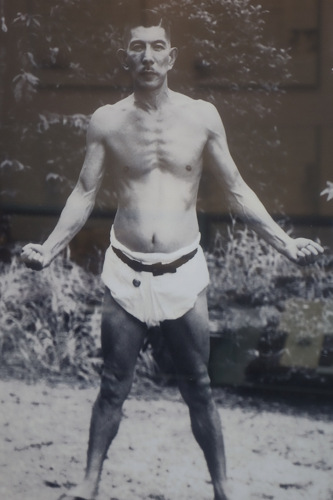 Tempukai founder Tempu Nakamura, in his youth
Tempukai founder Tempu Nakamura, in his youth
In theTempukai this is called “Sekkyoku-shin” (“positive mind” / 積極心). “Sekkyoku-shin” means to be free from all distracting thoughts (無念無想). Becoming one with the spirit of the universe through a state of Mushin (“empty mind” / 無心) is called Sekkokyu-shin.
If one were to speak of the “state of Shuchu” in older terms, we would say “universal” (宇宙的). The way of training the mind is the same. The idea that oneself in a “state of Shuchu” is the master means that one must claim responsibility. That is to say, one becomes unable to blame the opponent for the things that occur with one’s own body. People often say that they were injured by an opponent – even in Italian soccer games losses are blamed on poor referees or some other kind of external cause.
Everything is your own fault. Seeds that are not sown will not grow. Whatever happens with your own body is all the seeds of your own sowing. You must create your own place in accordance with this great principle and rule over it yourself.
I am explaining the mental state necessary for the training method that produces this. When one is training in the dojo they are always the leader. For that reason, that which occurs within your own body cannot be blamed upon another. Whatever the situation is, it is also the same in everyday life.

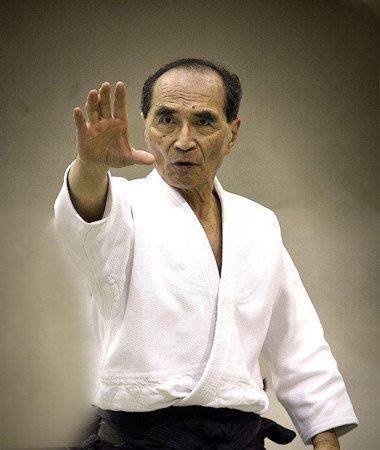
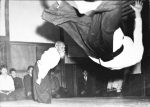
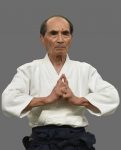

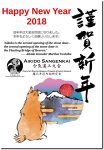


Leave a Reply